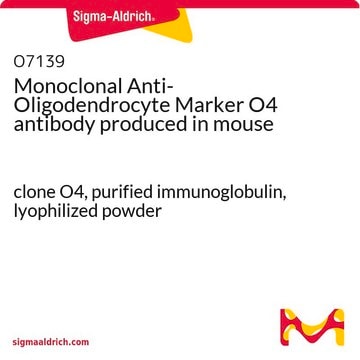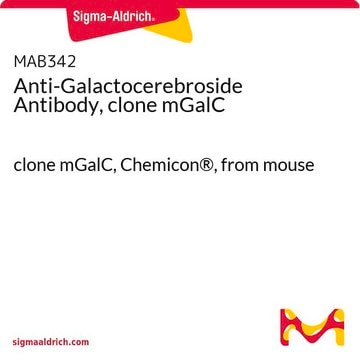MAB345M
Anti-O4 Antibody, clone 81
clone 81 (mAB O4), Chemicon®, from mouse
Sinônimo(s):
Sulfatide
About This Item
Produtos recomendados
fonte biológica
mouse
Nível de qualidade
100
300
forma do anticorpo
purified immunoglobulin
tipo de produto de anticorpo
primary antibodies
clone
81 (mAB O4), monoclonal
reatividade de espécies
rat, mouse, human, chicken
fabricante/nome comercial
Chemicon®
técnica(s)
immunocytochemistry: suitable
immunohistochemistry: suitable
Isotipo
IgM
adequação
not suitable for Western blot
not suitable for immunoprecipitation
Condições de expedição
wet ice
modificação pós-traducional do alvo
unmodified
Especificidade
Aplicação
Immunocytochemistry: 10-20 μg/mL on cells fixed with 4% paraformaldehyde.
Note: O4 is a sulfatide, which can be dissolved out of the membrane by organic solvents; acetone and methanol should not be used for fixation.
Optimal working dilutions must be determined by the end user.
Immunohistochemistry protocol
1. Prepare sections from unfixed, shock frozen tissue. The sections should be 4-5 μm thick. Place the sections on microscope slides.
2. Wash the slide three times for 5 min. each in PBS at room temperature.
3. Block the non-specific binding sites by incubating the sections in a humid chamber with 5% FCS at room temperature for 30 minutes.
4. Wash the slides as described in step 2.
5. Cover the sections with a sufficient amount of MAB345 (10-20 μg/mL in PBS) and incubate in a humid chamber at 37°C for one hour.
6. Wash the slides briefly three times with PBS. Carefully dry around the area to be stained.
7. Cover the sections with a sufficient amount of anti-mouse IgM-fluorescein* solution and incubate in a humid chamber at 37°C for one hour.
8. Wash the slides as described in step 6.
9. Cover the sections with a suitable embedding medium, cover with a cover slip, and examine by fluorescence microscopy.
*HRP or ABC can also be used.
Optimal results can be obtained by titrating the primary and secondary antibodies
Immunocytochemistry
1. Fix the preparations with 4% paraformaldehyde (in PBS) at room temperature for 10 minutes. O4 is a sulfatide which can be dissolved out of the membrane by organic solvents; acetone and methanol should not be used for fixation.
2. Wash the slide three times for 5 min. each in PBS at room temperature.
3. Block the non-specific binding sites by incubating the sections in a human chamber with 5% FCS at room temperature for 30 minutes.
4. Wash the slides as described in step 2.
5. Cover the sections with a sufficient amount of MAB345 (10-20 μg/mL in PBS) and incubate in a humid chamber at 37°C for one hour.
6. Wash the slides briefly three times with PBS. Carefully dry around the area to be stained.
7. Cover the sections with a sufficient amount of anti-mouse IgM-fluorescein solution and incubate in a humid chamber at 37°C for one hour.
8. Wash the slides as described in step 6.
9. Cover the sections with a suitable embedding medium, cover with a cover slip, and examine by fluorescence microscopy.
Note: Do not allow the preparations to dry out during staining.
forma física
Nota de análise
Rat cortical stem cells or day 3 cell cultures of brains from mouse embryos
Outras notas
Informações legais
Não está encontrando o produto certo?
Experimente o nosso Ferramenta de seleção de produtos.
Código de classe de armazenamento
10 - Combustible liquids
Classe de risco de água (WGK)
WGK 2
Certificados de análise (COA)
Busque Certificados de análise (COA) digitando o Número do Lote do produto. Os números de lote e remessa podem ser encontrados no rótulo de um produto após a palavra “Lot” ou “Batch”.
Já possui este produto?
Encontre a documentação dos produtos que você adquiriu recentemente na biblioteca de documentos.
Active Filters
Nossa equipe de cientistas tem experiência em todas as áreas de pesquisa, incluindo Life Sciences, ciência de materiais, síntese química, cromatografia, química analítica e muitas outras.
Entre em contato com a assistência técnica








